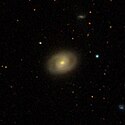NGC 3770
| Galaxie NGC 3770 | |
|---|---|
![NGC 3770 mit LEDA 35998 (ru)[1]](http://upload.wikimedia.org/wikipedia/commons/thumb/b/bd/NGC3770_-_SDSS_DR14.jpg/300px-NGC3770_-_SDSS_DR14.jpg) | |
| NGC 3770 mit LEDA 35998 (ru)[1] | |
| AladinLite | |
| Sternbild | Großer Bär |
| Position Äquinoktium: J2000.0, Epoche: J2000.0 | |
| Rektaszension | 11h 37m 58,744s[2] |
| Deklination | +59° 37′ 00,94″ [2] |
| Erscheinungsbild | |
| Morphologischer Typ | SBa [2][3] |
| Helligkeit (visuell) | 12,8 mag [3] |
| Helligkeit (B-Band) | 13,7 mag [3] |
| Winkelausdehnung | 1,0' × 0,7' [3] |
| Positionswinkel | 107° [3] |
| Flächenhelligkeit | 12,3 mag/arcmin² [3] |
| Physikalische Daten | |
| Zugehörigkeit | NGC 3963-Gruppe LGG 251 [2][4] |
| Rotverschiebung | 0.010841 ± 0.000163 [2] |
| Radialgeschwindigkeit | 3250 ± 49 km/s [2] |
| Hubbledistanz vrad / H0 | (149 ± 11) · 106 Lj (45,7 ± 3,3) Mpc [2] |
| Geschichte | |
| Entdeckung | William Herschel |
| Entdeckungsdatum | 19. März 1790 |
| Katalogbezeichnungen | |
| NGC 3770 • UGC 6600 • PGC 36025 • CGCG 292-012 • MCG +10-17-028 • IRAS 11352+5953 • 2MASX J11375873+5937011 • GC 2472 • H II 838 • h 926 • GALEXASC J113758.75+593700.3 • NSA 160252 • WISEA J113758.75+593700.8 | |
NGC 3770 ist eine Balken-Spiralgalaxie vom Hubble-Typ SBa im Sternbild Großer Bär am Nordsternhimmel. Sie ist schätzungsweise 149 Millionen Lichtjahre von der Milchstraße entfernt und hat einen Durchmesser von etwa 40.000 Lichtjahren. Gemeinsam mit sechs weiteren Galaxien ist sie Mitglied der NGC 3963-Gruppe (LGG 251).
Im selben Himmelsareal befindet sich u. a. die Galaxie NGC 3740.
Das Objekt wurde am 19. März 1790 vom deutsch-britischen Astronomen Wilhelm Herschel entdeckt.[5]
Weblinks
Einzelnachweise
Auf dieser Seite verwendete Medien
Autor/Urheber: Sloan Digital Sky Survey, Lizenz: CC BY 4.0
The sky image is obtained by Sloan Digital Sky Survey, DR14 with SciServer.
Angle of view: 4' × 4' (0.3" per pixel), north is up.
Details on the image processing pipeline: https://www.sdss.org/dr14/imaging/jpg-images-on-skyserver/



